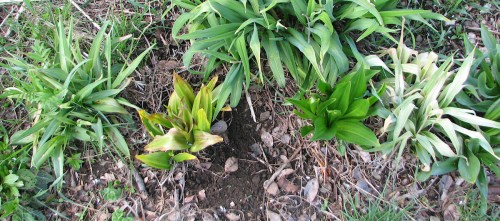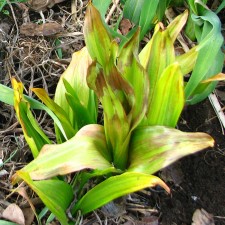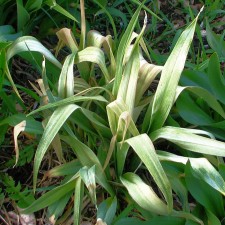
These plants don’t look too happy, but I’m not sure if it’s the cold that put them in a snit, or a viral infection. Left to right: Daylily 2E, Colchicum giganteum, Daylily 4B, C. ‘Harlequin,’ Daylily 4C, C. speciousum
After nearly two weeks of warm, frost-free weather in April, my garden got socked with a 22 degree (-6C) night. I would like to think these poor plants are suffering from frost damage, but I know streaking in the leaves is a symptom of many plant viruses.


Please, faithful readers, if any of you have seen plants with this kind of leaf damage and know what it is, I’d love to benefit from your expertise. If you click on either of the above close-ups, you will get a much larger image that may make diagnosis easier.




I’m sorry in that I also agree it looks like frost.
The very purpose of frost is to eliminate the environment of plant viruses and similar. It is nature’s way of sustaining balance, which is not a negative, but a positive and if we see it in that light, it becomes more acceptable & manageable. Here in South Africa (where we are severely under-estimated), we have reasonably affordable, white frost covering, protecting plants & herbs, yet allowing sufficient light. It is not the same material as that used on huge plant farms – more for the home gardener.
It works and is worth it just as much as the therapeutic value of growing for ourselves or even a small business.
Good luck!
Kathy, how are the plants looking now, a few days later? I bet they will still bloom despite the leaf situation. Let us know!
~ Monica
Ouch! I am sorry to hear about the frost – that looks like frost damage to me. Hopefully, that is the end of any frost in your area!
Great information! I live in Montana and the weather here is quite hard on plants. I have found that planting small plants in containers and leaving them indoors as long as possible works great. Then it works great to bury the container up to the rim in the desired spot.
With this there is no disturbing the root and that helps the plant withstand temperature changes.
The daylily looks like frost damage to me. I recognize that fainting white colour.
Hope they make a full recovery.
I’ll “third” what the others said. I think it is frost damage. If it were disease, wouldn’t you have seen signs of it before the frost?
My guess is frost, for what it’s worth. I had some similar looking damage a few nights ago on some cauliflower recently transplanted (in northern Vermont).
It sure looks like frost damage to me, but I’m far from being an expert.
I’m sorry they got nipped, but they should look better with a little good weather.